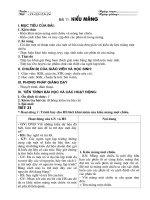GA 10NC-Unit 1-1
Bạn đang xem bản rút gọn của tài liệu. Xem và tải ngay bản đầy đủ của tài liệu tại đây (36 KB, 3 trang )
UNIT 1: SCHOOL TALKS
Period 1: (READING: TEXT + EXERXISE a)
Time: 45 minutes
Date of preparation: 4.9.2006
Date of teaching: 5.9.2006
I. AIMS AND OBJECTIVES :
1. Educational aim: - To enable the pupils to know about school activities and the
helpfulness of studying in group.
- After the reading lesson, the pupils can have better methods of
studying.
2. Language:
- Language function: Talking about school activities.
- Vocabulary: improve, locate, identify, strategy, attentive, cooperative, diversity, face –
to – face, interaction.
- Structures: Revision of the simple present tense.
3. Skills: Reading (scanning, skimming)
II. METHOD: integrated, mainly commmunicative.
III. TECHNIQUES: Question-Answer, Summary Mapping.
IV. TEACHING AIDS NEEDED: Textbook, pictures.
V. PROCEDURE:
Teaching steps
and time
Teacher’s activities Students’ activities
I. Stabilization:(2’)
II. Presentation of
the new
material: (37’)
-Checks absence …
WARMER: (5’) Goes around the class and
asks the pupils about their summer holiday.
PRE-READING: (Before You Read) (15’)
-Asks the pupils to look carefully at the
pictures in the textbook and then work in pairs
to answer the questions.
-Asks some pupils to stand up to answer the
questions and give reasons.
-Feedback.
-Answer keys
a.Studying in group.
b.Studying individually.
* I prefer to study in group because I can share
my ideas with friends / I can get new ideas
from friends.
* I prefer to study individually because I want
to think about the problem independently.
-Leads the pupils to the topic of the text.
-Presents some new words:
-The monitor answers.
-The pupils on duty answer
the teacher’s questions.
-Look at the pictures, work
in pairs and answer the
questions.
-The pupils on duty answer
the questions.
-Listen.
-Listen.
-Copy down the words, the
III.Consolidation:
(3)
III.Homework:
(3)
+ improve (v) : to make something better.
+ locate (v) : to find the place / position of
something / someone.
+ identify (v) : (example) (nhaọn ra)
Example: These two girls are twins. They look
alike. I cant identify them.
+ strategy (n) : (translation) Chieỏn lửụùc.
+ attentive (adj) : giving close attention to
something / somebody.
Example: He usually understands the lessons
well because he is always attentive to the
teachers teaching.
+ cooperative (adj) : working together for a
common purpose.
+ diversity (n) : = variety.
Example: There is a diversity of fish in the
sea.
+ face-to-face (adj) : (action)
+ interaction (n) : communication (sửù tửụng
taực)
WHILE-READING: (Reading Text) (17)
-Tells the pupils the aim of the exercise and
then gives clear instructions to do the exercise.
-Asks the pupils to read the text individually
and then do exercise a) in pairs.
-Asks some pupils to stand up and give the
result.
-Feedback.
-Answer keys:
1. T 2. T 3. NI 4. F 5. F
Correcting wrong information:
4. You should choose team mates with
shared interests.
5. A small team allows more face-to-face
interaction and is easier to get together.
-Asks the pupils to repeat the new words
above once more.
-Asks the pupils to learn the new words by
heart, read the text again and prepare exercise
b) and c).
examples and their
meanings, then practise
reading them.
-Listen.
-Read the text individually
and then work in pairs to do
exercise a).
-The pupils on duty give
result.
-Listen.
-Copy down the answer
keys and the corrected
information.
-Repeat the words after the
teacher.
-Listen and keep in mind.
2
V. Self - evaluation :
……………………………………………………………………………………………………………………………………………………………………………………
……………………………………………………………………………………………………………………………………………………………………………………
……………………………………………………………………………………………………………………………………………………………………………………
3









